Discover Fukushima
.jpg)
Welcome to Fukushima
Fukushima Prefecture, located in the Tohoku region of Japan, is a captivating destination offering a mix of natural beauty, rich history, and unique cultural experiences. Despite being widely known for the Fukushima Daiichi Nuclear Power Plant disaster in 2011, the prefecture has made significant strides in rebuilding and has much more to offer visitors. Here are some highlights:
Stunning Natural Landscapes: Fukushima is blessed with picturesque landscapes and natural wonders. From the expansive Inawashiro Lake, the fourth-largest lake in Japan, to the scenic beauty of Bandai-Azuma Skyline, a scenic driving route through volcanic landscapes, the prefecture provides breathtaking views throughout all seasons.
Historical Sites: Fukushima boasts several historical sites, such as the iconic Tsuruga Castle in Aizuwakamatsu, which offers panoramic views of the city and a glimpse into Japan's feudal past. The Ouchijuku village, a well-preserved Edo-period post town, allows visitors to step back in time with its traditional thatched-roof houses and charming atmosphere.
Vibrant Festivals: Fukushima is known for its vibrant festivals that showcase the region's traditions and culture. The Aizu-Wakamatsu Festival, held in late September, features colorful processions, music performances, and samurai parades, giving visitors a taste of historical Japan. The Koriyama Music Festival is a popular event that celebrates classical, jazz, and world music, attracting artists from around the globe.
Skiing and Outdoor Activities: With its mountainous terrain, Fukushima offers excellent skiing and snowboarding opportunities during the winter months. Several ski resorts, including Alts Bandai and Grandeco Snow Resort, provide well-groomed slopes and breathtaking winter landscapes. In warmer months, outdoor enthusiasts can enjoy hiking, cycling, camping, and watersports.
Hot Springs and Relaxation: Fukushima is home to numerous hot springs, known as onsen, which are perfect for relaxation and rejuvenation. Locations such as Higashiyama Hot Spring Village and Sukayu Onsen offer therapeutic baths amidst serene natural settings.
Culinary Delights: Fukushima's cuisine is renowned for its fresh and seasonal ingredients. Sample local specialties such as Aizu-gyu (Aizu beef), Kitakata ramen (noodles known for their thick, flat shape), and Fukushima sake, which is produced using traditional brewing techniques.
Fukushima Prefecture offers a diverse range of attractions, blending history, nature, and culture. The warm hospitality of its people, combined with the prefecture's resilience and ongoing recovery efforts, make it a compelling destination to explore and experience the best of Japan.
Destinations
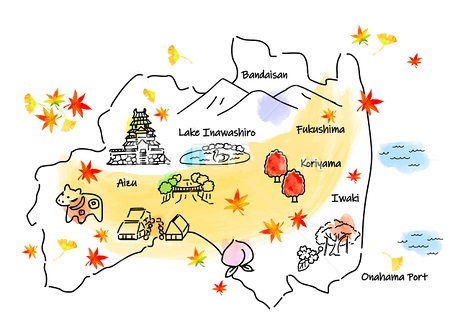
Easily reached from Tokyo, Fukushima has everything Japan is famous for, including relaxing onsen, sake, cherry blossoms and powder-covered mountain slopes
Fostering unique traditions of food and culture, the fertile lands of Fukushima produce some of Japan's best fruit and sake. Nature is abundant here, and international and local visitors have long been drawn to its famed onsen and pristine wilderness. More recently, winter sports enthusiasts have discovered Fukushima's charms. While the 2011 earthquake and tsunami hit the region hard, the spirit of the samurai culture of the western Fukushima and Aizu regions, and the attitude of persistence and determination has contributed to the recovery of the tourism industry through steady efforts.
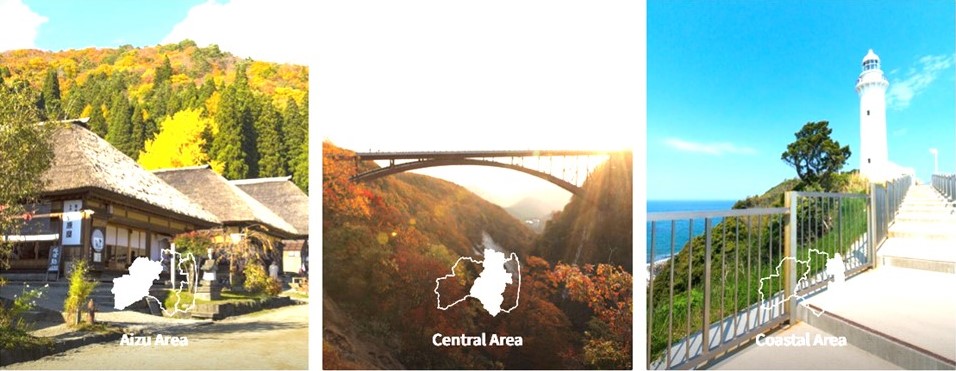
Some Popular destinations include
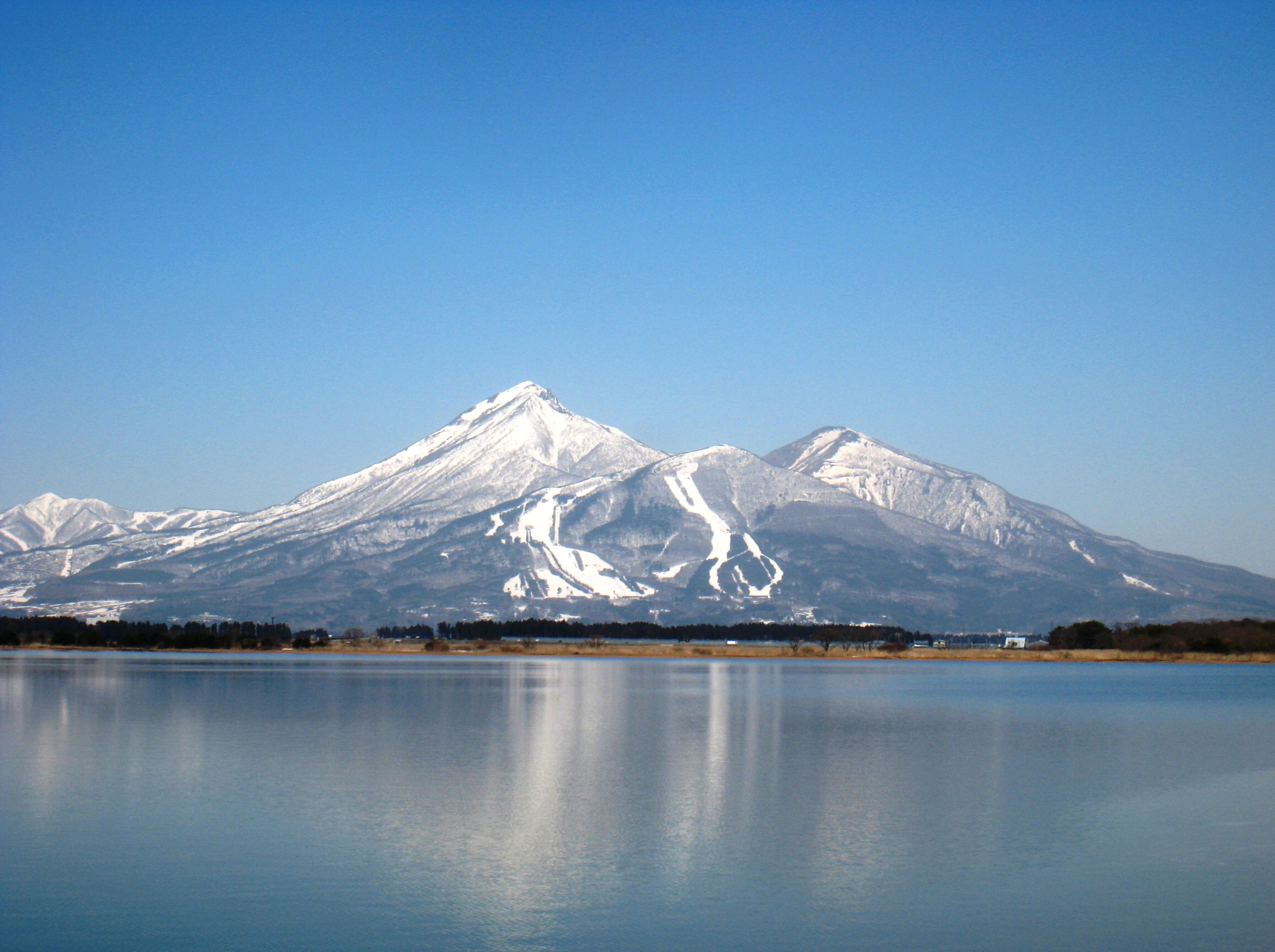
Mount Bandai
Mount Bandai is often referred to as the Mount Fuji of Fukushima, and, just like Fuji, it is also surrounded by an incredible landscape, which was largely formed when Mount Bandai last erupted, on July 15, 1888.
The region surrounding the mountain is known as Urabandai, which translates to “behind Bandai.” But in 1950 the area officially became recognized for its beauty and became the Bandai-Asahi National Park. Urabandai is a region with stunning landscapes at every turn, and if you are looking for a place to escape to from the city, Urabandai could not be recommended enough, along with its many activities that cater to each season.
Today there are many ways to enjoy Mount Bandai with the most rewarding being a hike along one of the many scenic trails to its peak.
The most recommended of the trails is the Happoudai Trail, which is the most accessible and has a conveniently located carpark close to its entrance. From here, the hike will take around two hours to reach the summit. However, if you would like more of a challenge, there are other trails in the area which range from three to seven hours.
Once you have reached the top of Mount Bandai, its rocky peak is truly a sight to behold — so much so that you may not want to leave. If you are lucky enough to hike on a clear day, then from the summit you will be rewarded with panoramic views of Lake Inawashiro, Japan’s fourth largest lake; the historic castle town Aizu Wakamatsu, which is famous for its long samurai lineage; and the Azuma mountain ranges.
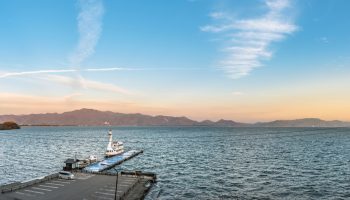
Lake Inawashiro
The waters of Lake Inawashiro have been a mesmerizing attraction for thousands of years. Gaze at the clear surface and you'll see the reflection of towering Mt. Bandai and the skies. What's known as “Heavenly Mirror Lake” is also the fourth-largest lake in Japan.
In summer, go for a swim, do some fishing, or enjoy water sports such as boardsailing and water skiing. On the northern shore in Nagahama, camping provides a leisurely way to take in all the natural beauty. After a long day, slide into one of the area's several hot springs.
You can get to the lake by taking a train to Aizu-Wakamatsu Station, and then taking bus or taxi.
From Tokyo, take the Tohoku Shinkansen to Koriyama Station, about 90 minutes away. Transfer at Koriyama Station to Inawashiro Station. Use the 40-minute rapid train going to Aizu-Wakamatsu via the Banetsu West Line. You can take bus or taxi services to nearby areas such as Mount Bandai and Ura-bandai area.
Some hotels offer shuttle services from Koriyama Station.
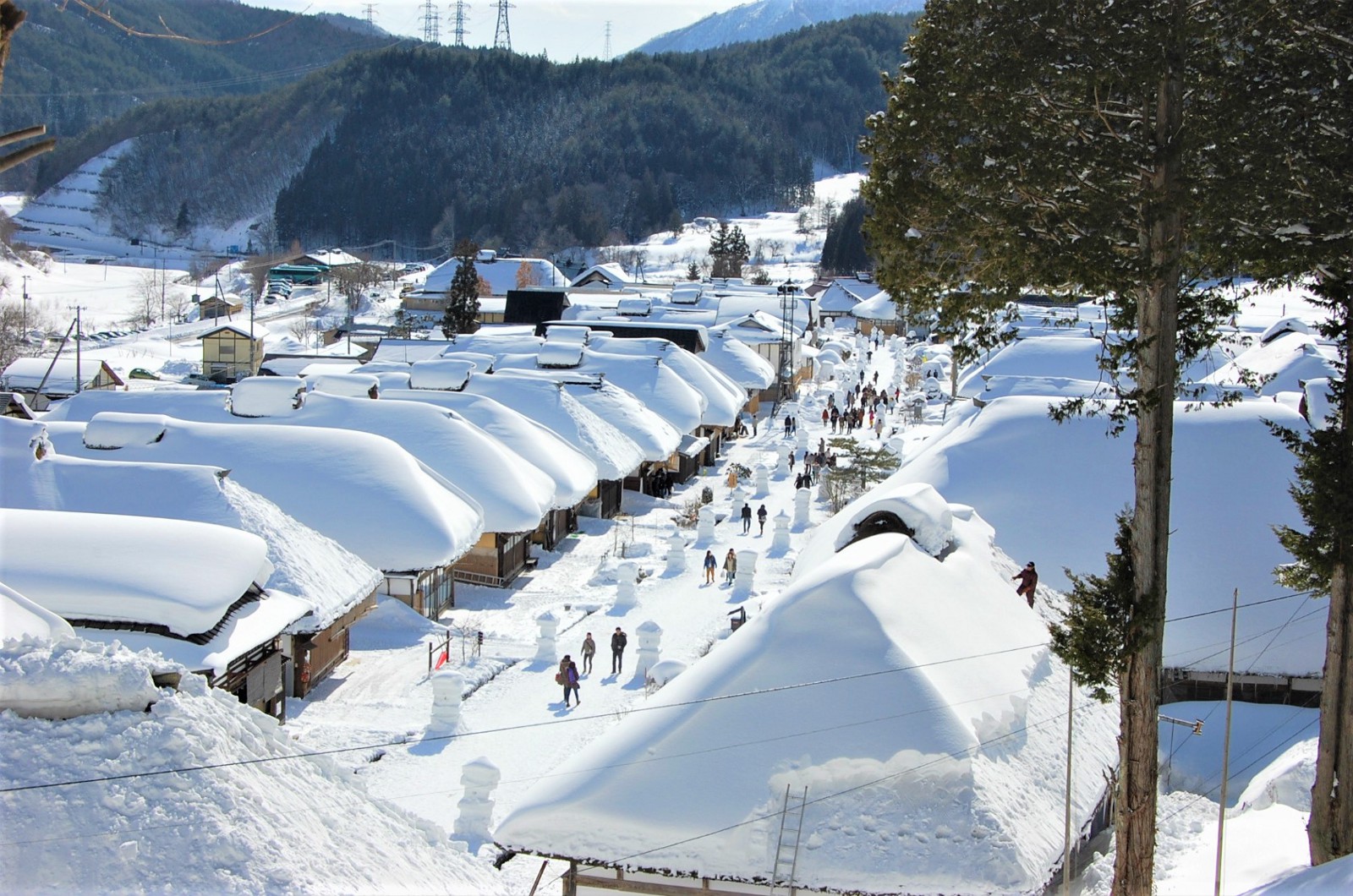
Ouchi-Juku
As a former post town (shukuba; 宿場) that opened in 1643, Ouchi Juku (大内宿) prospered during the Edo period due to its prime location along the Aizu-Nishi Kaidō, an important historic route that connected Aizu to Nikko in Tochigi Prefecture.
In the past, travellers who passed by Ouchi Juku would make a pit stop there for a brief break or an overnight stay, before continuing on their journey.
Built over 400 years ago, the dwellings are covered with a special thick roof made with Japanese pampas grass, which allows houses to stay cool in the summer and warm during the colder months.
Nowadays, the dwellings which line the street house a variety of shops, restaurants, and even traditional inns. Walk through the main street and you can imagine yourself present during the town’s heyday in the 17th century.
Operating hours of the shops vary, but most are open from 11am to 4pm.
Ouchi Juku is best accessible from Yunokami Onsen Station, which is served by Aizu Railway’s Aizu Line. A one-way trip from Aizu Wakamatsu Station costs ¥1,050 and takes around 30-40 minutes.
From there, a 15-minute taxi ride will bring you to Ouchi Juku. Between mid March to November, a bus runs between the station and Ouchi Juku at relatively frequent intervals. Day passes are available for purchase at ¥1,100 for adults and ¥500 for children.
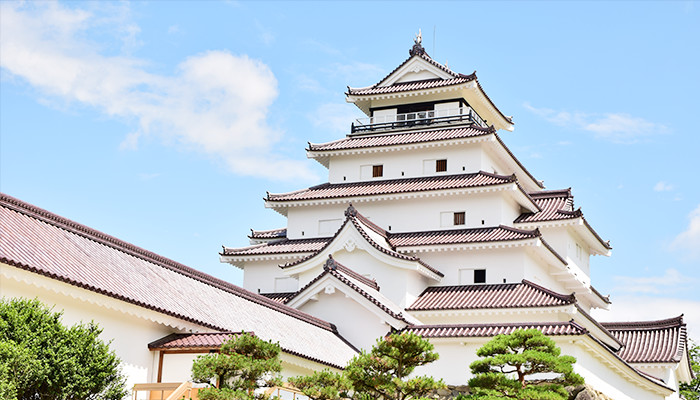
Aizu Wakamatsu Castle
Tsurugajo Castle allows visitors the opportunity to experience history, nature, and tradition with all five senses.
Despite being mostly reconstructed, the surrounding park's stone walls remain in their original state. In 2010, for the first time since it was refurbished in 1965, the castle underwent a cosmetic restoration. Following completion in 2011, the same red-tile roofs seen by the Byakkotai (during the Boshin War and finals days of the Tokugawa shogunate) are now displayed for all to see.
This castle is one of the final strongholds of samurai that remained loyal to the shogunate and today stands as a symbol of courage and faithfulness.
Within the castle tower's museum, the swords and armor of the castle’s successive lords are on display. Visitors can watch a CG-enhanced theatrical video reflecting on the great history of Aizu.
In addition to the historical atmosphere surrounding Tsurugajo, visitors can sense the changes that have occurred throughout history, thanks to the engaging and informative museum within the castle walls. It’s fun to gaze across Aizu from the fifth floor, like a feudal lord admiring his domain—the viewing platform up here provides panoramic views taking in Mt. Bandai and Mt. Iimoriyama.
The castle is also a must-see in the springtime when approximately 1,000 cherry trees offer a magnificent display within the castle's grounds.
When you’re in the mood for a rest, visit the Rinkaku Tea Rooms for some freshly-prepared matcha green tea. This tea house on the grounds of Tsurugajo was vital in the spread of this traditional art—and had it been destroyed during the Meiji Restoration, tea ceremony as it is known in Japan might have vanished.
Tsurugajo Castle is truly a place where the modern visitor can slip into the past and become immersed in history.
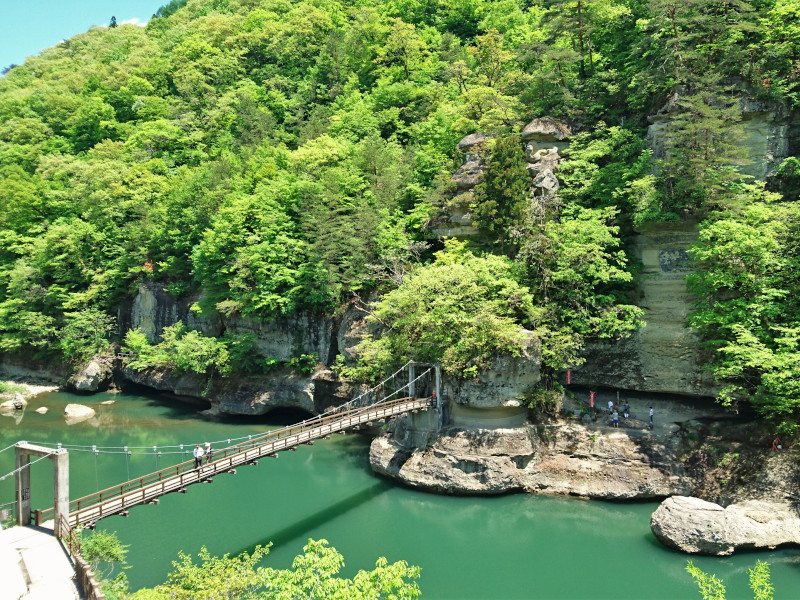
Tō-no-Hetsuri
A national natural monument, To-no-hetsuri Crags consists of tower-shaped cliffs overlooking Okawa River. Hetsuri is an Aizu word meaning "a cliff overlooking a river" or "a steep slope" in the local dialect.
These strange-shaped cliffs are thought to be made of various types of rocks formed around 28 million years ago and feature deep cracks along the vertical joints. Thanks to trees growing between the white multi-layered rocks the view in autumn is quite spectacular. In spring and summer, the lush greens create a beautiful carpet down the rocks; in winter, the heavy snows make To-no-hetsuri Crags look otherworldly.
Visitors to the area of To-no-hetsuri Crags can best enjoy the dynamic scenery by crossing the nearby suspension bridge. The suspension bridge offers a breathtaking sight of the river and cliff sides. At the foot of the cliff there is also a small shrine dedicated to the Bodhisattva of Wisdom. Another great way to enjoy To-no-hetsuri Crags is from the observatory neighboring the area where guests can view a panoramic scene of Okawa River, To-no-hetsuri Crags, and the suspension bridge. After enjoying the beautiful sight, head over to the local shopping area for restaurants and souvenirs.
Getting Around
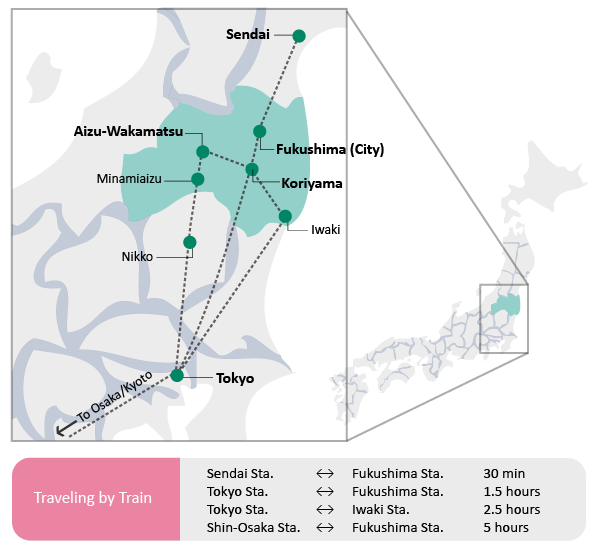
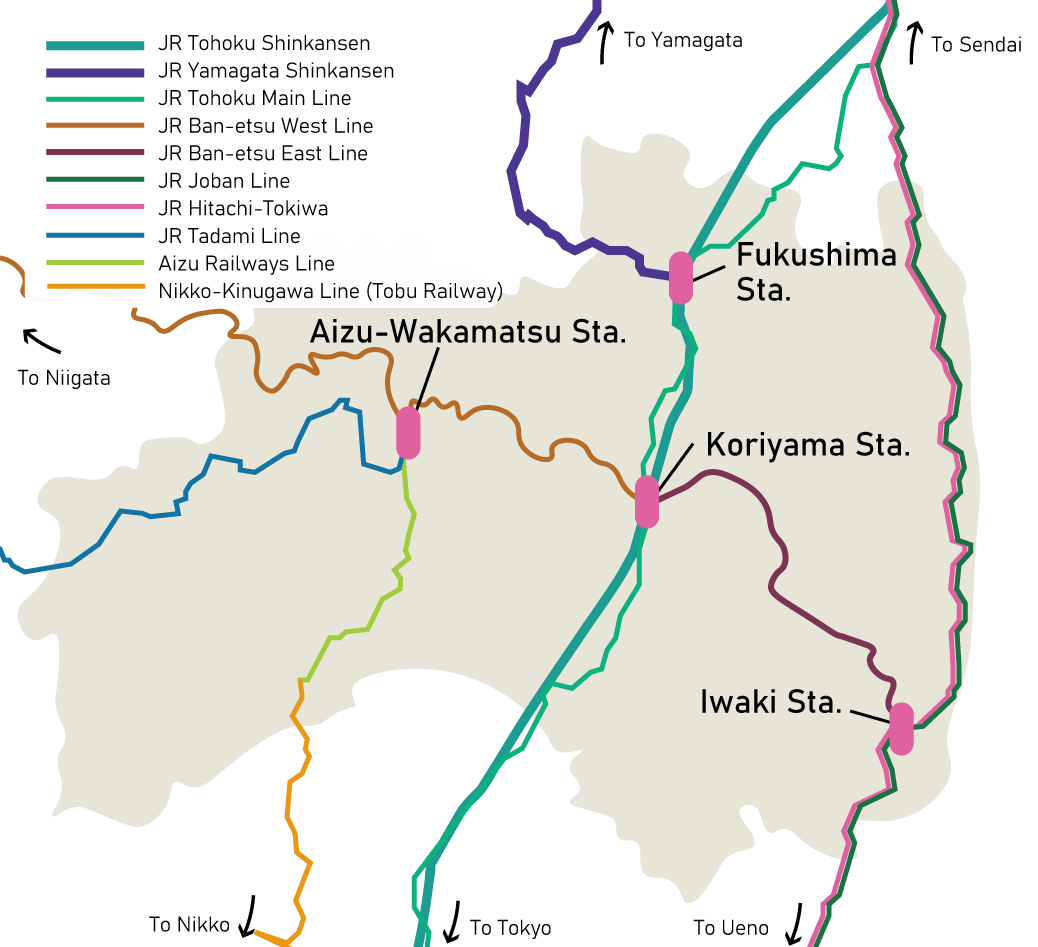
From Tokyo
Tokyo to Koriyama
Traveling to JR Koriyama Station puts you at the center of Fukushima Prefecture, with easy access to the whole prefecture.
JR Tohoku Shinkansen 1 hr 15 min from Tokyo or Ueno Station (7,470~7,680 yen+)
Expressway Bus (JR Bus Tohoku) 4 hr 10 min (prices vary)
From Osaka
For JR Rail Pass holders, using local JR lines in combination with Shinkansen lines is the best option for cost and time efficiency. If you don’t mind sitting longer, the night bus will save you money. Whichever option you choose, it’s recommended to reserve tickets in advance.
Osaka ↔ Fukushima
JR Kyoto Line + JR Tokaido Shinkansen + JR Tohoku Shinkansen ~5 hr (~21,000 yen+)
Night Bus + JR Tohoku Shinkansen ~10 hr 30 min (~14,000 yen+)
Flight (Itami Airport -> Fukushima Airport) ~1 hr 10 min (~25,000 yen+) (one way)
More Specific Access Information can be found here
https://fukushima.travel/page/access
Detials on Getting Around Fukushima Prefecture can be found here
https://fukushima.travel/page/get-around
